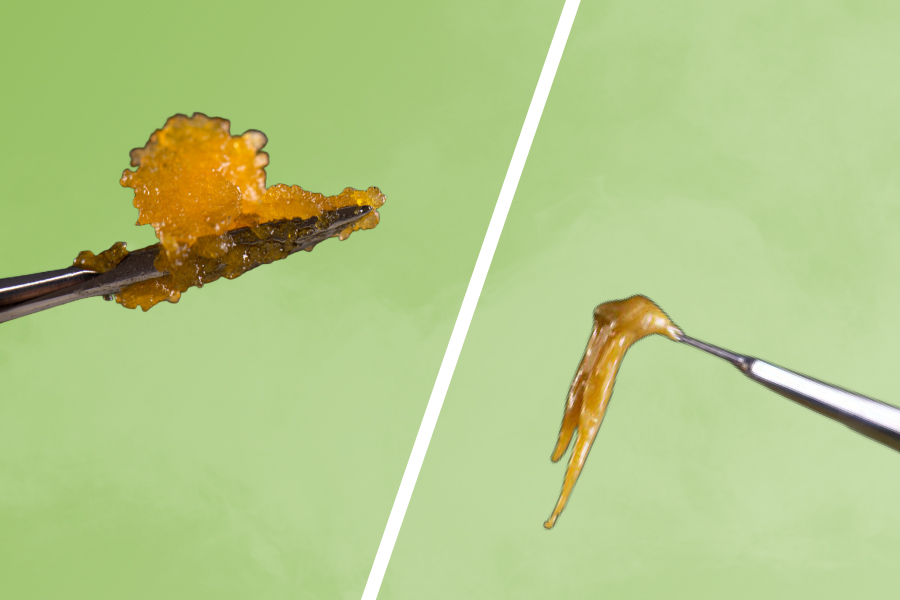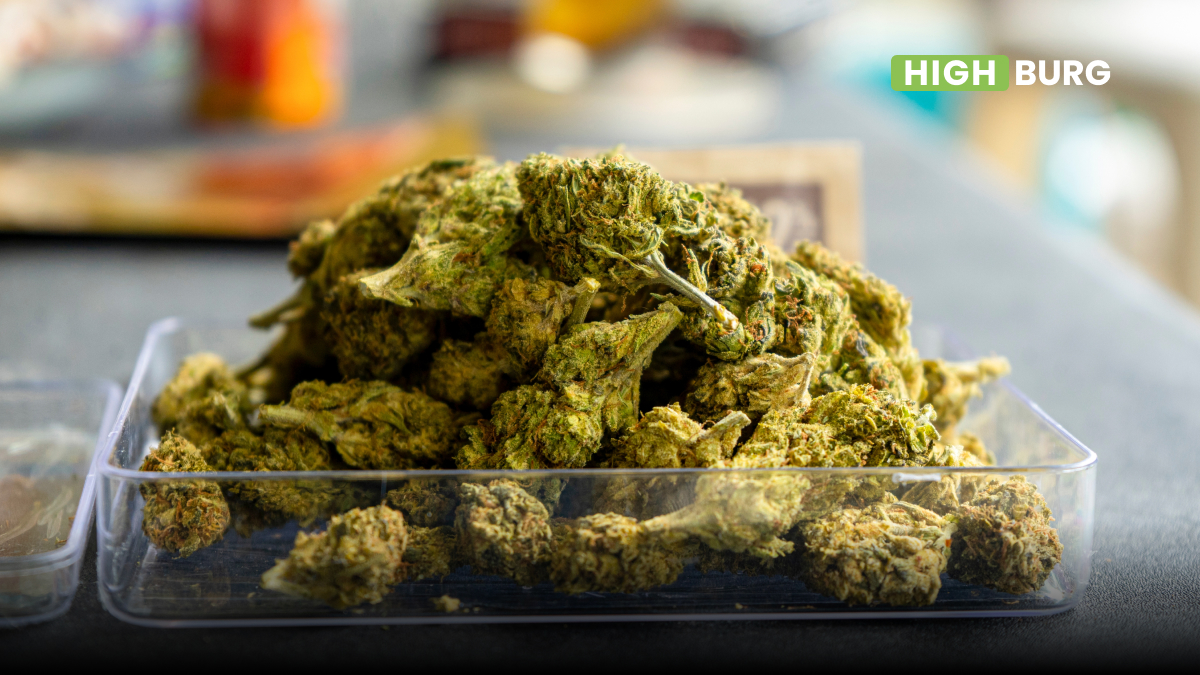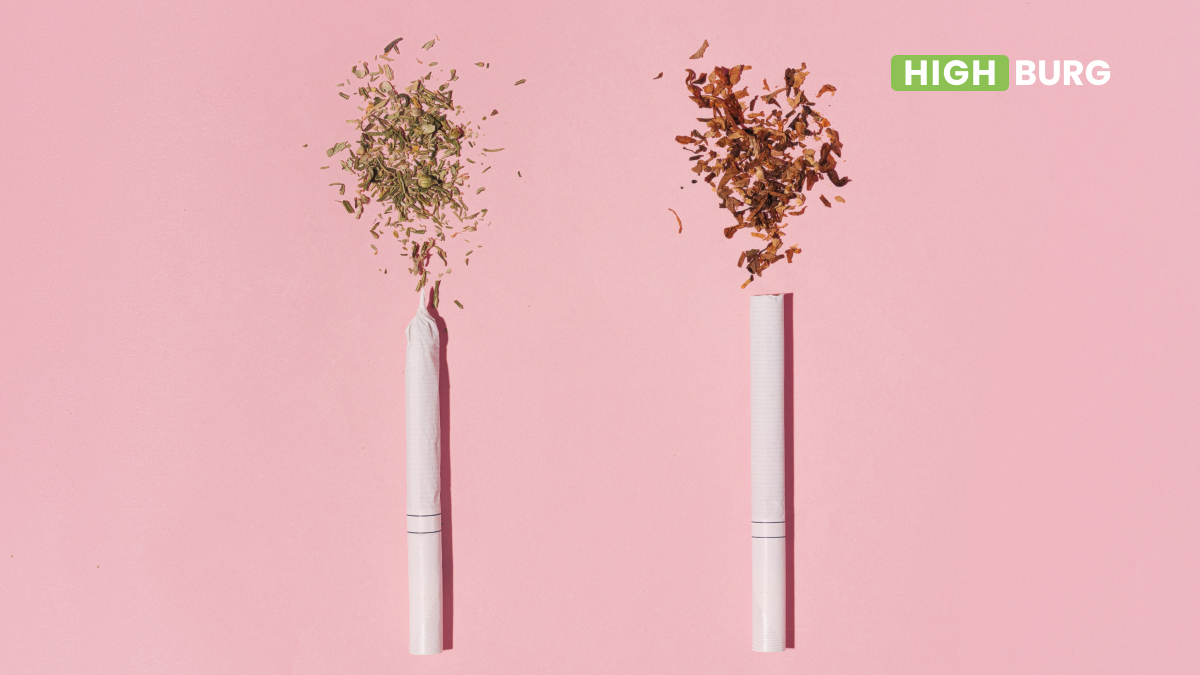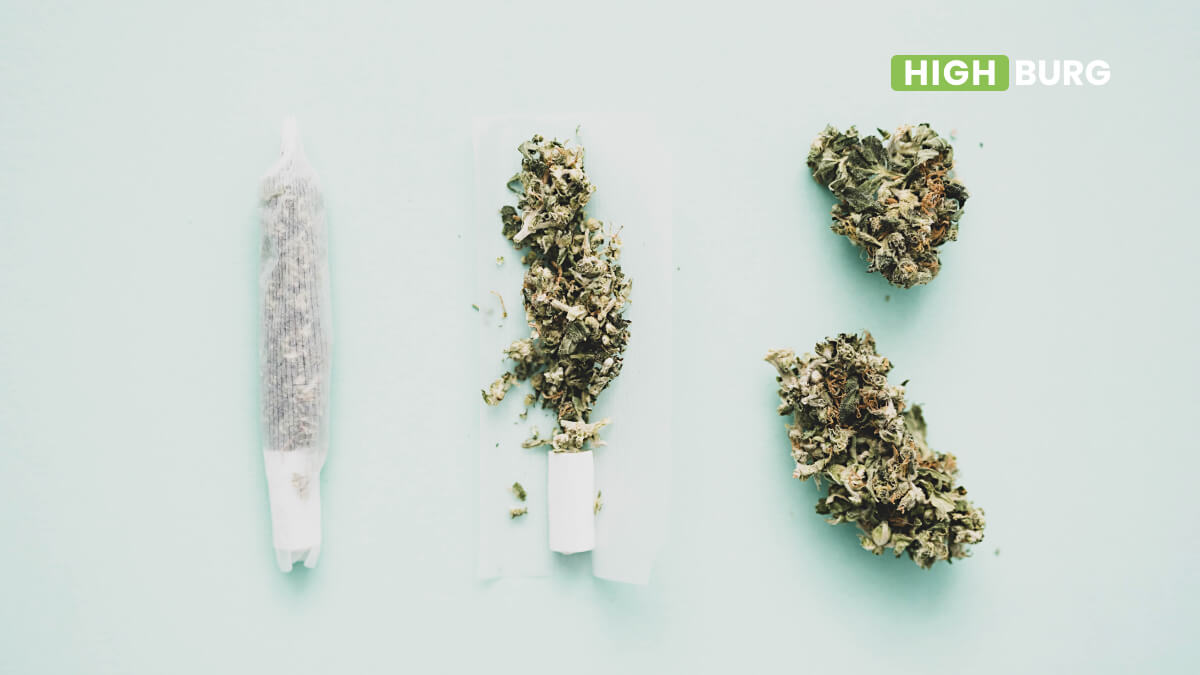If you’re into cannabis concentrates, then you’ll want to know more about live resin vs rosin so that you’re not confused the next time you try one out.
While the ever-growing and expanding popularity of different cannabis concentrates continues to rise, so does the number of users who may not know what the main differences are between all of the concentrate products that are available out there.
This can make it difficult to know which products will be right for your own personal needs and preferences since different cannabis concentrate products have their own set of unique qualities, effects, and uses, as well as varying concentrations of cannabinoids.
In this article, we’ll help break down some of the main differences between two very popular types of concentrates that you’re likely to encounter in your local dispensary: live resin vs rosin.
Live Resin – What Is It?
Live resin is a type of cannabis concentrate that is made using fresh, undried cannabis flowers. The process of making live resin begins with freezing the freshly harvested cannabis plants, which helps to preserve the terpene profile. Once frozen, the plant material is then put into a closed-loop extraction system where the cannabinoids and terpenes are extracted.
The final product is a concentrate that contains all of the aromatic compounds found in the fresh plant material. Live resin also retains its potency for much longer than traditional hash oil products, with an estimated shelf life of up to two years.
Advantages Of Live Resin
There are many advantages to using live resin over other types of concentrates. Here are five of them:
High Terpene Content
Terpenes are the chemicals that give plants their smell and taste. They’re also known to have medicinal properties. Live resin is made from fresh cannabis plants that haven’t been dried out yet, so it contains more terpenes than other types of concentrates like hash or kief because those products are made from dried-out flowers or trim leaves instead.
Better Flavor Experience
You can taste the difference between a regular flower and live resin immediately upon inhaling it into your lungs — especially if you’re smoking through a pipe or joint with a paper filter on it like most people do these days (e-nails don’t use paper filters).
Drawbacks Of Live Resin
One drawback of live resin is its price point – it can be twice as expensive as other concentrates such as rosin or shatter due to the extra processing involved in creating it.
Another downside is that it’s not always possible to get a full gram of live resin from every pound of cannabis because the process does require more plant material to produce. But if you want the best quality cannabis concentrate on the market, live resin may be worth it.
What Is Rosin?
Rosin is another form of cannabis concentrate made through pressure and heat. When we say pressure, we mean some weight pressing down on the flower and when we say heat, we mean applying some sort of heat (either by a torch or hot skillet) to create vaporization.
When enough pressure has been applied, moisture evaporates off the flower material and leaves behind sticky resins. These resins are then scraped off before being cured for 12 hours at room temperature (65 degrees Fahrenheit). There’s no need to use any solvents like butane during this process, so rosin is cleaner than most other types of concentrates.
However, this also means that its effects are weaker because you’re consuming less THC. Additionally, rosin tends to come in two varieties- hard and soft. Hard rosin is brittle while soft rosin is more malleable which can make it easier to work with if you’re not using a dab rig or vape pen.
It also has different qualities that each have its own pros and cons- harder rosin is better for vaping whereas softer rosin is perfect for smoking. Both require a higher temperature to be consumed properly and they should never be vaped below 350 degrees Fahrenheit.
Advantages Of Rosin
There are a couple of advantages to rosin:
Safety
It’s safer than butane hash oil (BHO) because it doesn’t use any solvents or toxic chemicals during the extraction process.
Quality
It produces high-quality oils with little to no impurities, which means you don’t have to worry about the solvent residue that’s common with other concentrates.
Convenience
You don’t need expensive equipment to produce rosin at home. Some methods can even get the job done by just using a hair straightener and parchment paper or silicone mats.
Drawbacks Of Rosin
The main drawback of rosin is that it can sometimes be difficult to work with, especially for beginners. If you’re not careful when making your own rosin, you can end up with a sticky mess. Additionally, there are some drawbacks of rosin that you should know about before trying it out.
Rosin also has a lower THC content than other concentrates such as shatter or wax. This means that you may need to use more rosin than other types of cannabis products if you want to get high.
Rosin is also harder to make at home compared to other concentrates. It requires a steady hand, some skill, and patience (not everyone has those three things).
Live Resin Vs Rosin – The Differences Between The Two
The biggest difference between live resin vs rosin is how they are extracted from the plant. Live resin is created when trichomes are still wet after harvest while rosin is created after dried flowers have been heated up.
Consequently, live resin produces a richer aroma and tastes smoother due to lower levels of terpenes evaporating off into thin air as it’s pressed together. Furthermore, since live resin only requires about an hour to produce compared to four hours for rosin, live resin will often cost more per gram since there’s less waste involved.
You can taste nuances in flavor in live resin that you won’t find in rosin because the flavor hasn’t been burnt off.
Rosin is easier to work with in comparison to live resin. Because of how easy rosin is to use, it’s become increasingly common among novice concentrates users. It also doesn’t need a ton of fancy, expensive equipment to make it.
Their Process
Live resin is a type of cannabis concentrate that’s created by extracting the cannabinoids from the cannabis plant while it is still fresh. This process results in a product that is high in terpenes and flavonoids, giving it a strong smell and flavor.
Rosin is a concentrate that has grown in popularity. It is created by heating up cannabis buds until they are almost dry, which causes them to release oils onto parchment paper or some other kind of material. Then, pressure or heat (like using a hair straightener) is applied on top of the oiled surface, squeezing out the oils and turning them into something like shatter or wax.
Rosin has become increasingly popular because unlike other types of concentrates such as butane hash oil (BHO), it doesn’t require any specialized equipment and can be done at home without too much trouble. However, many people have raised concerns about residual solvent from butane leaks making their way into rosin cartridges causing them to combust unexpectedly during use.
How Do You Make Live Cannabis Resin?
The process of making live resin begins with freshly harvested cannabis that is flash-frozen immediately after harvest. This helps to preserve the delicate trichomes that contain all of the plant’s terpenes.
Once frozen, the plant material is then put into a closed-loop extractor where it is washed with a solvent like butane or propane. This process strips the terpenes away from the cannabis plant material while leaving behind a golden amber liquid concentrate.
That concentrate is then carefully heated at precise temperatures in order to evaporate off the solvent, which leaves behind a purer form of THC in its natural oil form. Depending on how much heat was applied during this final step, the resulting product can be made into either a dry sift wax or oil.
If you have been smoking weed for any length of time, chances are you have smoked both types before; the only difference between these two concentrates lies in their consistency and texture.
How Is Live Resin And Rosin Consumed?
Live resin and rosin are two of the fastest-growing concentrates in the cannabis industry. These extracts are made using a solventless process and can be consumed in many ways. Here’s how:
1. Vaping
Live resin and rosin are ideal for vaping because they produce a flavorful vapor with minimal coughing and throat irritation.
Vaping live resins allows for more precise dosing than smoking flower or concentrates because there’s no need for decarboxylation (heating the product) before use; when vape pens heat up live resins, they convert cannabinoids into their active form immediately so they can be used right away by your body without having to wait.
When you vape live resin, you get the best of both worlds: You experience the terpene profile of the strain and you get the effects of THC and CBD. This makes for a very powerful and unique experience that can’t be replicated with many of the other concentrates out there.
2. Eating
If you’re not ready to switch over to vaping, live resin or rosin can still be enjoyed by eating it in a form of food like brownies, cookies, or gummies. The effects of eating live resin will be slower than vaping, but the flavor is much stronger. If you prefer eating edibles made with concentrates instead of smoking them, this might be your best option.
3. Dabbing/Dab Rig
Some people prefer dabbing over other methods because it produces a stronger effect than ingesting or vaping concentrates alone. A dab rig is typically used for this purpose since it’s less messy than using a bong or pipe full of oil (although you can use either type).
Dabbing involves placing a tiny amount of concentrate on top of a heated surface called a “nail” or “rig.” You then inhale through an attached glass tube called a “rig”.
What Are Some Types Of Live Resin?
There are many types of live resin, each with its own unique properties.
Badder/Budder
Badder/budder weed concentrate is a type of marijuana that has been extracted from the cannabis plant and then heated to create a thick, sticky substance that can be smoked or vaped.
Badder is also known as wax. It is made in a similar way to hashish, but with higher temperatures applied to the extracted product. Badder provides a stronger high than regular flower, with some users reporting an intense experience.
Sugar
Cannabis sugar concentrate is a form of cannabis extraction that has started to grow in popularity in recent years. It is often referred to as “BHO,” but this is not an accurate term, as it is not made using butane gas.
Cannabis sugar concentrate can be produced in several different ways. The most common method involves using ethanol to extract cannabinoids and terpenes from dried flower buds. This process can be done at home with basic equipment like a coffee filter and a large glass jar that has been filled with enough water to submerge the cannabis leaves completely.
Shatter
Cannabis shatter concentrates are known for their high potency, which can range from 50% to 90% THC. They’re also known for their unique texture and taste, which some people describe as having notes of pine or lemon (a result of terpenes).
Although they look like glass and have similar properties to glass in that they break easily if dropped on a hard surface, they’re actually made from butane gas or propane gas (the same substances used in lighters) and will therefore evaporate over time.
How Do You Dose Concentrates?
Dosing cannabis concentrates can be tricky, especially for first-time users. The process is made even more difficult when trying to compare two similar products, live resin, and rosin.
There are two ways to dose live resin vs rosin: by weight, or by volume.
Dosing by Weight
If you want to make sure that you’re getting the same amount of dabs from every hit, it’s best to measure out your dose using a scale. This gives you greater control over the amount of concentrate you use and allows you to experiment with different amounts based on your tolerance level and personal preference.
The most common way to dose by weight is with a gram scoop. A gram scoop is a small tool used to scoop up a certain amount of material and deposit it into a container. These are commonly used in dispensaries when purchasing flower, but can also be used for concentrates such as live rosin or shatter.
Dosing by Volume
This method of dosing works well if you don’t have access to a scale or are looking for something quick and easy. You simply take an empty container (like an empty glass bottle) and fill it with however much product you want – this is typically 1-2 grams of rosin or live resin per container. Then all you need to do is shake it up until everything mixes together!
The dosage of cannabis concentrates can vary widely, depending on not only the specific type of concentrate you’re using but also the quality of it. Concentrates are usually measured by weight or volume, so it’s important to know how much of your product will be consumed when you use a given amount.
For example, if you use an oil cartridge with a 3:1 THC concentration ratio, then each puff is equal to 3 milligrams (or 300 micrograms) of THC per hit. Dabbing is another common way of consuming concentrates that allow users to precisely control their dose by using tiny amounts at a time.
When using dabs, the rule of thumb is that one gram of concentrate contains 100 milligrams or more of THC – but this varies depending on the quality and potency of the product.
Because it’s difficult to quantify how much cannabis you consume when using edibles or other types of products like tinctures and topicals, it’s important to start with small doses when trying something new for the first time.
Final Thoughts On Live Resin Vs Rosin
In the ever-expanding environment of cannabis concentrates, there are many different options to choose from. But when it comes down to it, there are really only two types that matter: live resin vs rosin. Both of these concentrates have their own unique benefits that make them stand out from the rest. So, which one is right for you?
It all depends on what you’re looking for in a cannabis concentrate. If you want something that is incredibly potent and has a great flavor, then live resin is the way to go. But if you’re looking for something that is a bit more budget-friendly, then rosin is the better option.
Ultimately, it all comes down to personal preference. So, try out both and see which one you like best!



